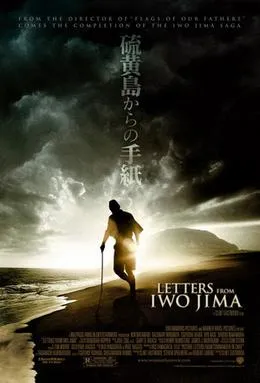Historical accuracy of Letters from Iwo Jima

Historical accuracy of Letters from Iwo Jima

Characters
General Tadamichi Kuribayashi
Kuribayashi was the actual commander of the Iwo Jima garrison. His background and unconventional defense strategy depicted in the film are historically accurate.
Baron Takeichi Nishi
Nishi was a real, famous figure who died on Iwo Jima. His aristocratic background, fame, and reported interactions (like with the wounded American) are based on historical accounts.
Saigo
Saigo is a fictional character created to represent the perspective of an ordinary, unwilling conscript, contrasting with the professional soldiers and fanatics.
Shimizu
Shimizu is fictional, representing soldiers with different backgrounds and perhaps disillusionment. His backstory highlights the harshness of the Kempeitai.
Lieutenant Ito
Ito likely represents or is a composite of younger, fiercely nationalistic officers who clashed with Kuribayashi's pragmatic strategy and preferred traditional "banzai" attacks.
Lieutenant Colonel Oiso
Oiso served as Kuribayashi's chief of staff on Iwo Jima.
More characters
Captain Tanida
Likely a fictional character representing the middle-ranking officers carrying out orders within the bunker system.
Lieutenant Okubo
Represents officers who disobeyed Kuribayashi's orders against futile charges, a documented issue during the battle. The specific character is likely fictional/composite.
Nozaki
A fictional character representing the comradeship among common soldiers.
Kashiwara
A fictional character whose death highlights the severe impact of disease and poor conditions on the Japanese soldiers.
Story
Kuribayashi's strategy: defense-in-depth, tunnels
Kuribayashi rejected traditional beach defense and ordered the construction of extensive underground fortifications, focusing on attrition warfare.
Extensive tunnel network construction
The Japanese forces built miles of complex tunnels and bunkers on Iwo Jima, which formed the core of their defensive strategy depicted accurately in the film.
Severe shortages of supplies (water, food)
The Japanese garrison suffered from critical shortages, particularly fresh water, leading to widespread illness (like dysentery) and weakening the troops.
Letters used as narrative framing
While based on real letters found after the war (compiled by Tsuyuko Yoshida), the specific letters read in the film are dramatized representations, not direct transcriptions.
Clash between pragmatism and Bushido fanaticism
Kuribayashi faced resistance from subordinates who favored suicidal "banzai" charges over his orders for a prolonged defense, reflecting real tensions in the Japanese military.
Baron Nishi reads letter from US soldier's mother
This incident is based on accounts suggesting Nishi treated a captured/wounded American kindly, possibly involving a letter. Details vary, but the event's essence is plausible.
Soldiers forced to commit suicide with grenades
Mass suicides and pressure to commit suicide to avoid capture were common among Japanese forces, especially as defeat became inevitable.
Officers executing soldiers attempting surrender
There were instances where Japanese officers or zealous soldiers killed comrades who tried to surrender or appeared defeatist, as depicted with Shimizu.
Kuribayashi's final attack and death
Kuribayashi led a final, disorganized attack. The exact circumstances of his death remain unknown; suicide, dying in combat, or ritual beheading are all possibilities reflected uncertainly in the film.
Saigo buries Kuribayashi's letter bag
Saigo is fictional, so this specific event didn't happen. The letters were discovered years later by Japanese authorities clearing the island, not buried by a surviving soldier.
Lack of Japanese naval and air support
The Japanese garrison was effectively cut off and received almost no support from the Imperial Navy or Air Force during the main battle.
Brutality and desperation of the battle depicted
The film effectively portrays the horrific conditions, intense close-quarters combat within tunnels, and the sheer desperation of the Japanese defense.
Focus on Japanese humanity and perspective
The film's strength is portraying the Japanese soldiers not as stereotypes but as individuals with families, fears, and differing motivations, based on their letters.
Shimizu's Kempeitai backstory causing suspicion
While Shimizu is fictional, the portrayal reflects the fear and mistrust associated with the Kempeitai within the regular army.
Setting
Iwo Jima's volcanic terrain (black sand, Suribachi)
Filmed primarily in Iceland and California, the film effectively recreates the distinctive barren, volcanic landscape of Iwo Jima, including Mount Suribachi.
Japanese tunnel and bunker network
The claustrophobic, dark, and extensive underground fortifications central to the battle are realistically depicted, showing the conditions soldiers lived and fought in.
Japanese uniforms and personal equipment
The uniforms, helmets (often covered), Arisaka rifles, grenades, and other gear used by the Japanese soldiers appear authentic for the period.
American firepower (bombardment, flamethrowers)
Though seen from the Japanese perspective, the film conveys the overwhelming naval bombardment, air attacks, and use of flamethrowers by US forces against the bunkers.
Harsh living conditions inside bunkers
The film accurately portrays the suffering caused by heat, lack of water, poor sanitation, disease, and constant fear within the besieged tunnels.
Sound design of battle
The sounds of constant shelling, gunfire, and explosions effectively create an immersive and harrowing atmosphere of the intense battle.
Time period (Late stages of WWII - 1945)
The film is correctly set during the February-March 1945 battle, reflecting the desperate situation of Japan late in the war.
Atmosphere of impending doom and duty
The film successfully captures the pervasive sense of fighting a hopeless battle, mixed with the soldiers' sense of duty and varying degrees of fanaticism.
